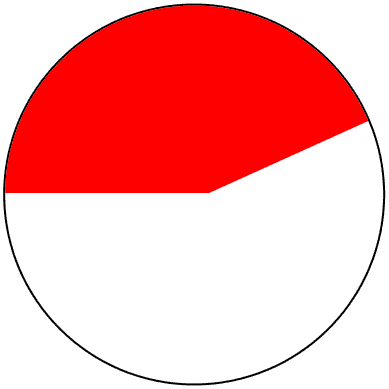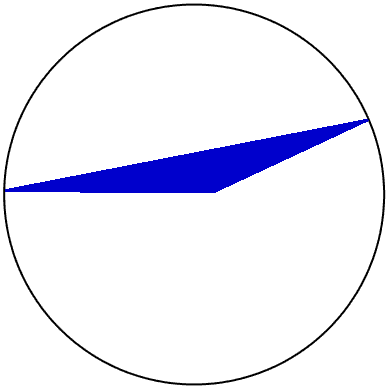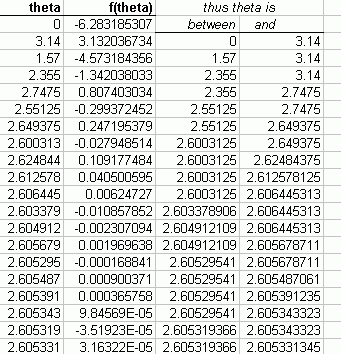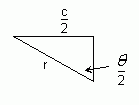| |||
| Math Central | Quandaries & Queries |
|
Where do you place a chord in a circle such that it divides the area of the circle 1/3 and 2/3? Also, what is the length of the chord? |
Hi Henry.
You are describing a circular segment whose area is (1 /3 )![]() r2 , but I suspect you already know that.
r2 , but I suspect you already know that.
The area of a circular segment can be deduced from the area of the circular sector and the area of the isosceles triangle within the circular sector. This diagram helps explain things:
 |
minus |  |
equals |  |
| A=½r2 |
A=½r2sin |
A=½r2( |
Thus, you want to solve (1 /3 )![]() r2 = ½r2(
r2 = ½r2(![]() -sin
-sin![]() ), which simplifies to 3
), which simplifies to 3![]() - 3sin
- 3sin![]() - 2
- 2![]() = 0. Note that the angle
= 0. Note that the angle ![]() is the central angle measured in radians.
is the central angle measured in radians.
This equation is not easy to solve. In fact, the easiest approach is to solve it numerically (that is, to find a close approximation).
Using a spreadsheet package, I calculated an approximation of f(![]() ) = 3
) = 3![]() - 3sin
- 3sin![]() - 2
- 2![]() .
.
Clearly, ![]() must be between zero and
must be between zero and ![]() radians, so using those as the initial boundaries, I quickly divided the range of possible values of
radians, so using those as the initial boundaries, I quickly divided the range of possible values of ![]() in half and zeroed in on the approximate value of
in half and zeroed in on the approximate value of ![]() that answers your question.
that answers your question.

So ![]()
![]() 2.6053 radians. Thus, a circular segment subtended by an angle of 2.6053 radians has an area of one third of the area of the circle itself.
2.6053 radians. Thus, a circular segment subtended by an angle of 2.6053 radians has an area of one third of the area of the circle itself.
The length of the chord can be calculated given the radius r and this angle ![]() using simple triangle geometry:
using simple triangle geometry:
 |
implies |  |
so sin(![]() / 2) = (c / 2) / r.
/ 2) = (c / 2) / r.
Hope this helps,
Stephen La Rocque.
 |
||
Math Central is supported by the University of Regina and The Pacific Institute for the Mathematical Sciences.